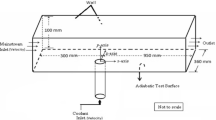Abstract
A numerical simulation has been performed for the investigation of flow and heat transfer characteristics of a film cooling system injected through a hole with compound angle orientation. The finite volume method is employed to discretize the governing equations based on the non-orthogonal coordinate with non-staggered variable arrangement. In order to analyze flow and heat transfer characteristics, velocity, temperature, aerodynamic loss coefficient, skin friction and vorticity are calculated with the variation of the skew angle. The maximum longitudinal vorticity and aerodynamics loss depend strongly on the skew angle. For the symmetric case of β=0 deg, a pair of counter-rotating vortices are formed and the maximum value of the film cooling effectiveness has appeared in the center plane where the skin friction is the minimum. For the skew angle of β=30 deg and above, only one strong counter-clockwise vortex remains in the downstream region and the maximum value of the film cooling effectiveness are obtained on the right side of the vortex. The predicted results for the film cooling effectiveness show good agreements with previous experimental data except the near-hole region.
Similar content being viewed by others
Abbreviations
- C fX :
-
Longitudinal skin friction coefficient
- C fZ :
-
Lateral skin friction coefficient
- C P, inj :
-
Total pressure loss coefficient measured with injection
- D :
-
Hole diameter
- D.R. :
-
Density ratio (=ρj/ρ∞)
- k :
-
Turbulent kinetic energy
- L :
-
Hole length
- M :
-
Blowing ratio (=ρj U j/{ρ∞ U∞})
- P inj :
-
Total pressure predicted with injection
- P k :
-
Production of the turbulent kinetic energy
- Pr, Pr t :
-
Laminar and turbulent Prandtl number
- P ∞ :
-
Freestream total pressure
- Re D :
-
Reynolds number based on the hole diameter
- U in, Tin :
-
Inlet velocity and temperature in the plenum region
- U j, Tj :
-
Jet exit velocity and temperature
- U ∞,T ∞ :
-
Freestream velocity and temperature of the main flow
- X :
-
Coordinate in streamwise direction
- Y :
-
Coordinate in normal direction
- Z :
-
Coordinate in spanwise direction
- α:
-
Inclined angle
- α jm :
-
Cartesian component of the contravariant base vectors
- β:
-
Skew angle
- δ:
-
Boundary layer thickness
- δn :
-
Normal distance from a wall
- ε:
-
Dissipation rate of the turbulent kinetic energy
- η:
-
Film cooling effectiveness
- κ:
-
Von-Karman constant
- μ, μt :
-
Laminar and turbulent viscosity
- ρj, ρ8 :
-
Density of injected and mainstream fluid
- σk, σε :
-
Turbulent diffusion Prantdl number fork and ε
- Γ:
-
Diffusion coefficient
- Ωx :
-
Longitudinal vorticity
References
Compton, D. A., and Johnston, J. P., 1992, “Streamwise Vortex Production by Pitched and Skewed Jets in a Turbulent Boundary Layer,”AIAA Journal, Vol. 30, No. 3, pp. 640–647.
Goldstein, R. J., Eckert, E. R. G., and Ramsey, J. W., 1970, “Film Cooling Following Injection Through Inclined Circular Tubes,”Israel Journal of Technology, Vol. 8, pp. 584–588.
Honami, S., Shizawa, T. and Uchiyama, A., 1994, “Behavior of the Laterally Injected Jet in Film Cooling: Measurements of Surface Temperature and Velocity Temperature Field within the Jet,”ASME J. of Turbomachinery, Vol. 116, pp. 106–112.
Lee, S. W., Kim, Y. B. and Lee, J. S., 1997, “Flow Characteristics and Aerodynamic Losses of Film-Cooling Jets with Compound Angle Orientations,”ASME J. of Turbomachinery, Vol. 119, pp. 310–319.
Leylek, J. H. and Zerkle, R. D., 1994, “Discrete-Jet Film Cooling: A Comparison of Computational Results with Experiments,”ASME J. of Turbomachinery, Vol. 116, pp. 358–368.
Ligrani, P. M. and Mitchell, S. W., 1994, “Interactions Between Embedded Vortices and Injectant from Film Cooling Holes with Compound Angle Orientations in a Turbulent Boundary Layer,”ASME J. of Turbomachinery, Vol. 116, pp. 709–720.
Rhie, C. M., 1981, “A Numerical Study of the Flow Past an Isolated Airfoil with Separation,” Ph. D. Thesis, Dept. of Mech., University of Illinois at Urbana-Champagn.
Sinha, A. K., Bogard, D. G. and Crawford, M. E., 1991, “Film Cooling Effectiveness Downstream of a Single Row of Holes with Variable Density Ratio,”ASME J. of Turbomachinery, Vol. 113, pp. 442–449.
Zhang, X. and Collins, M. W., 1993, “Flow and Heat Transfer in a Turbulent Boundary Layer Through Skewed and Pitched Jets,”AIAA Journal, Vol. 31, No. 9, pp. 1590–1599.
Author information
Authors and Affiliations
Rights and permissions
About this article
Cite this article
Lee, J.H., Choi, Y.K. A numerical study on flow and heat transfer characteristics of film cooling with a compound angle hole. KSME International Journal 12, 963–971 (1998). https://doi.org/10.1007/BF02945563
Received:
Issue Date:
DOI: https://doi.org/10.1007/BF02945563



